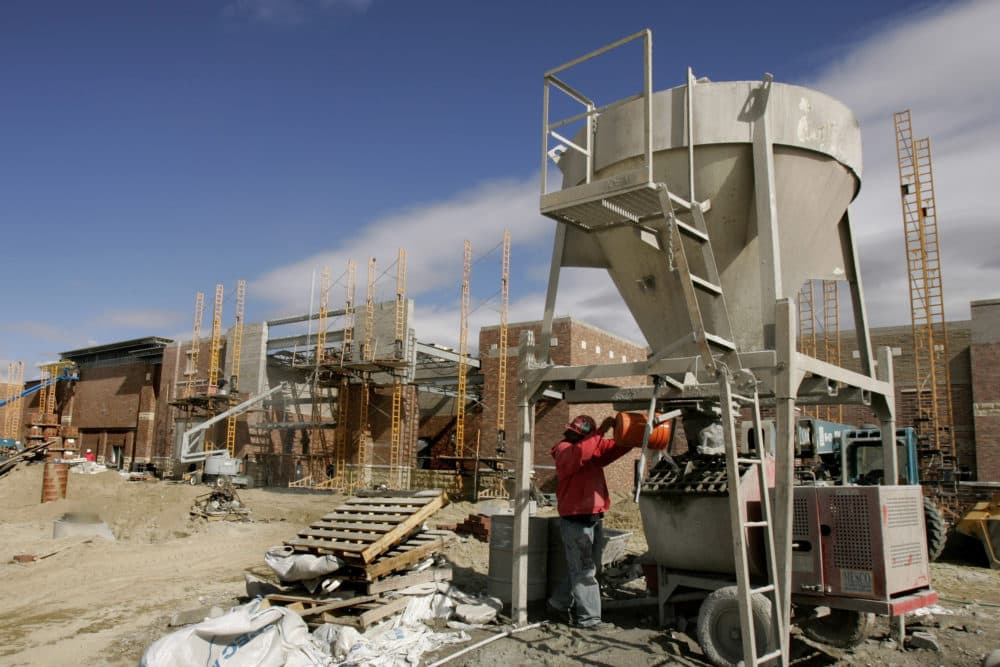Advertisement
Instead Of Fossil Fuels, This Startup Uses Mirrors And Sunlight To Mix Cement
Resume
If the cement industry were a country, it would be the third-largest carbon dioxide emitter in the world behind only China and the U.S.
The process used to mix cement not only gives off carbon dioxide as a byproduct, but it also requires a tremendous amount of heat that normally comes from fossil fuels.
Now, a startup solar power company called Heliogen has developed a new technology that could make industrial manufacturing renewable by using the power of the sun.
“To house the 7.5 billion people on Earth, and to build the roads, buildings, transportation, everything for them, the two biggest ingredients in our life are cement and steel,” says Heliogen CEO Bill Gross. “And both of those release a huge amount of CO2 because of the burning of the fossil fuels to make them. And we're enjoying the fruits of the benefit of those great materials but at a huge cost to the planet.”
So Heliogen came up with a solution. The company, which CNN reports is backed by an investment from Bill Gates, uses mirrors to magnify sunlight which creates temperatures hot enough to mix cement or create steel, Gross says. It created this “solar concentration field” in sunny Lancaster, California.
“We're essentially making an oven, a huge oven. We set it at 2,000 degrees Fahrenheit, which is basically one third the temperature of the surface of the sun,” he says. “It's a field of mirrors that are all perfectly computer controlled to reflect the sunlight to a single spot. We can make these high temperatures and now use the sun to power these industrial processes, like making cement, making steel, making glass.”
Before developing this technology, it wasn’t possible to power industrial manufacturing processes using the sun because the electricity produced from solar panels doesn’t reach high enough temperatures, Gross says.
“We're really excited to try and reduce emissions, and make these industrial processes possible with renewable for the first time,” he says.
These mirrors create a solar “death ray,” Gross says, which can be focused on something, like a cement mixer, to power it.
“Imagine you went into a football stadium and you were sitting with a mirror at one end and you want to reflect the light to someone at the other end. But now imagine all 50,000 people each have a mirror, and they're all reflecting it to one spot,” he explains. “Well, you need a lot of coordination and computer control to get that to happen perfectly, and that's a technology we developed.”
Right now, Heliogen is focusing on sharing the technology with factories that have land adjacent to the sun, Gross says. For those that aren’t in sunny areas, the company is working on methods to store and transport the solar power.
This kind of concentrated solar power could even be used to make hydrogen fuel, Gross says.
“Hydrogen is the single best fuel there is,” he says. “The problem with it is it's clean when you burn it, but it's dirty when you make it.”
Right now, hydrogen fuel is made through burning and splitting methane, a fossil fuel. But splitting water molecules would be a completely green way of making hydrogen fuel, he says.
“Well, it takes 1,450 degrees centigrade to split water, and we have already achieved more than that temperature” with our technology, Gross says. “So our goal long term is to use solar energy to split the water molecule, make fully green hydrogen, and that could really have an impact on reducing fossil fuel use, and of course, reducing CO2 emissions.”
Cassady Rosenblum produced and edited this interview broadcast with Todd Mundt. Samantha Raphelson adapted it for the web.
This segment aired on December 2, 2019.

